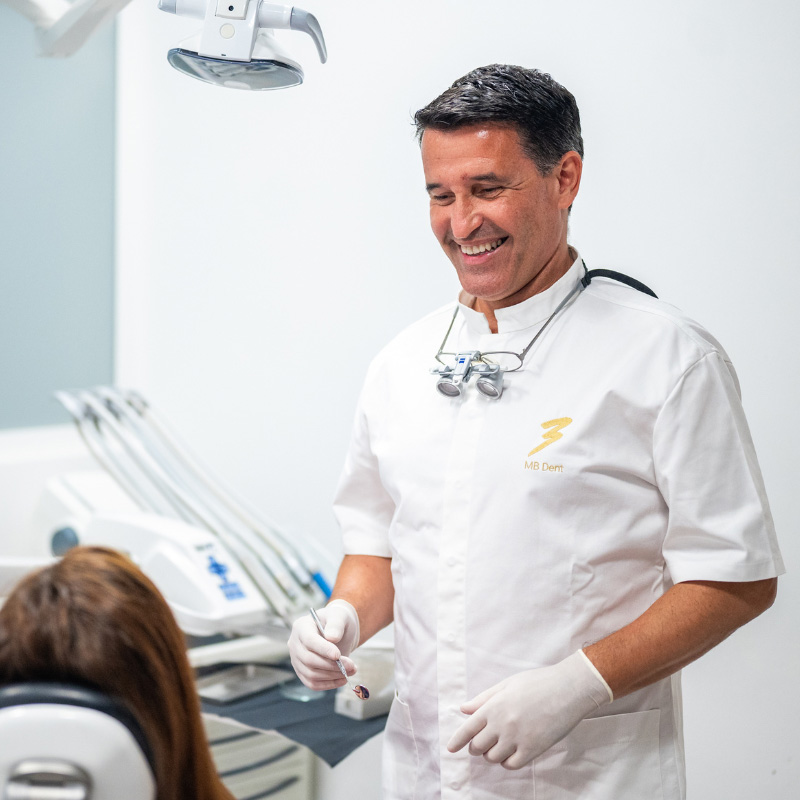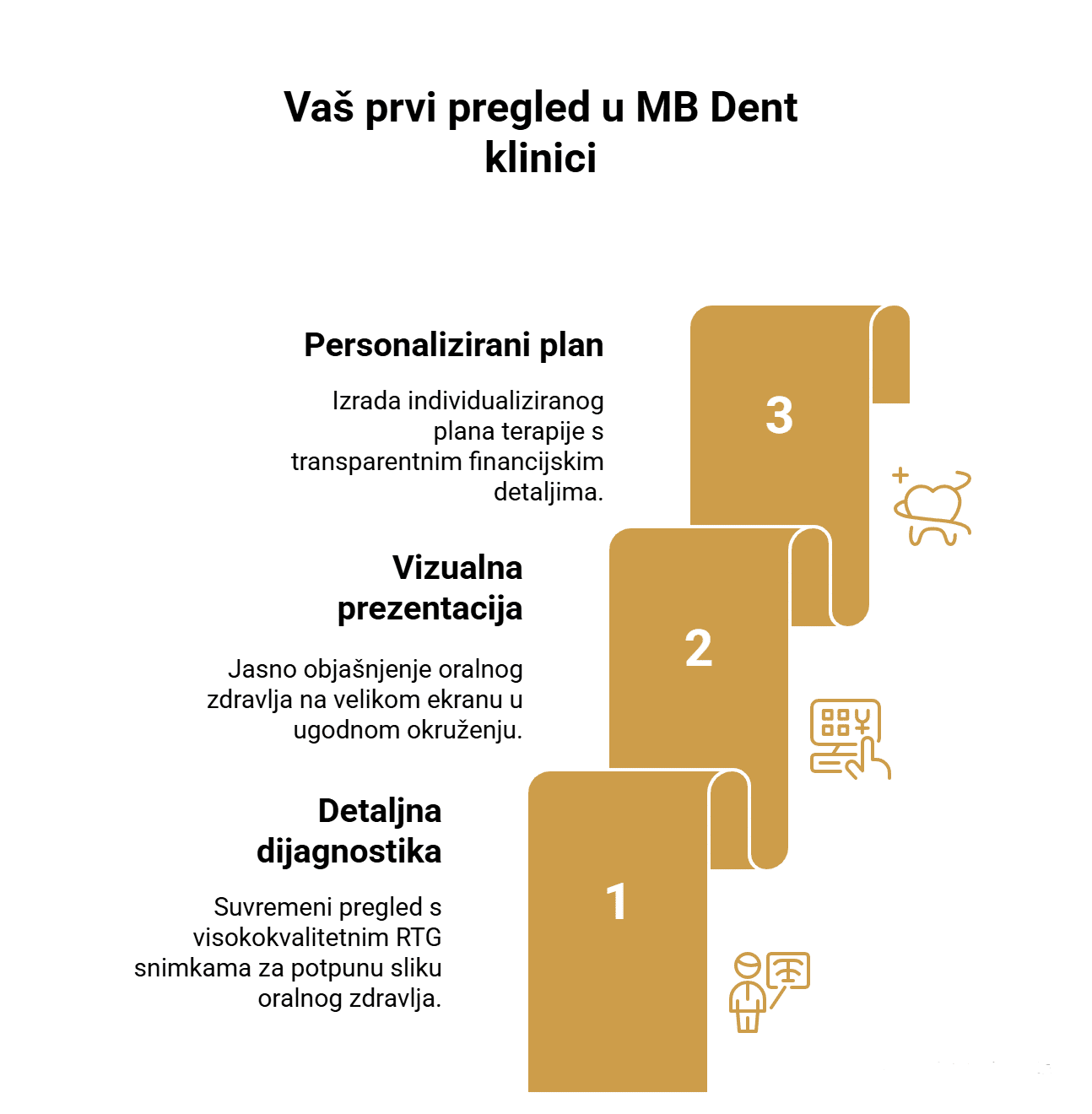A dental bridge is a structure placed over a ground-down tooth to reinforce, strengthen, and beautify it, with the primary purpose of replacing one or more teeth. A metal-ceramic bridge is a sturdy and aesthetically acceptable aid, which is also financially favorable. Non-metal ceramic is aesthetically more perfect and is made using special technology: CAD/CAM computer-guided system with specially adapted instruments, ensuring very high precision and eliminating the factor of human error.
What is a dental bridge?
A dental bridge is a dental prosthetic replacement used to replace one or more missing teeth. The name “bridge” comes from the fact that it spans the gap between the remaining teeth or dental implants, thereby restoring chewing function and the aesthetics of the smile.
A dental bridge usually consists of three parts:
- Crowns: Crowns are artificial teeth placed on the remaining natural teeth (known as abutments) on either side of the gap. The abutments are prepared to support the crowns and ensure the stability of the bridge.
- Artificial tooth (or teeth): The artificial tooth or teeth replacing the missing teeth are located in the middle of the bridge and are fitted where the gap is.
- Connection (retainer): The connection is the part of the bridge that links the crowns and artificial teeth. It can be visible or hidden, depending on aesthetic and functional needs.
There are different types of dental bridges, including traditional bridges, cantilever bridges, and implant-supported bridges. It’s important to consult with a dentist to determine which type of dental bridge is best for your specific situation.
When is a dental bridge used?
A dental bridge is used in cases where one or more adjacent teeth are missing, and it is necessary to restore chewing function, the aesthetics of the smile, and maintain oral health.
- Replacing one or more missing teeth: If one or more teeth are missing in a row, a dental bridge can fill that gap. The bridge will rely on the remaining natural teeth or dental implants on either side of the gap.
- Improving chewing function: Missing teeth can make it difficult to chew food, which can affect nutrition and digestion. A dental bridge helps restore normal chewing function.
- Preserving facial shape: Missing teeth can affect the shape of the face, causing sagging cheeks or changes in profile. A dental bridge can support the shape of the face and prevent these changes.
- Improving speech: Missing teeth can affect the pronunciation of certain sounds and cause speech problems. A dental bridge can improve speech ability.
- Aesthetic correction: Dental bridges also play a role in improving the aesthetics of the smile, especially when the missing teeth are visible when smiling.
- Maintaining the position of remaining teeth: Missing teeth can lead to the shifting of the remaining teeth, which can affect the bite and overall oral balance. A dental bridge can help maintain the position of the remaining teeth.
- Combination with implants: Dental bridges can also be used in combination with dental implants to replace missing teeth.
What types of dental bridges are there?
Depending on your situation, the dentist will recommend one of the types of dental bridges:
- Traditional fixed prosthetic bridges: These are the most common type of dental bridges and consist of artificial teeth connected by crowns placed on the remaining natural teeth on each side of the gap. The crowns are permanently cemented to the teeth, making the bridge stable and durable.
- Cantilever bridges: This type of bridge uses minimally ground teeth, onto which thin porcelain veneers are placed. Cantilever veneers are typically used when adjacent teeth are already slightly damaged, and the desired result can be achieved without the need for full grinding.
- Implant-supported bridges: These bridges use dental implants as support instead of natural teeth. The implants are inserted into the jawbone and serve as a stable base for the bridge. This option is particularly useful when adjacent teeth are also healthy, and you do not want to further grind them.
- Removable bridges: These bridges, also known as partial dentures, are temporary solutions that can be removed. They are used if the natural teeth around the gap are too weak to support a fixed bridge.
- Mixed bridges: Combine fixed and removable elements. It’s possible for one part of the bridge to be fixed with crowns, while another part uses removable elements that can be taken out.
What is the procedure for installing a dental bridge?
The installation of a dental bridge consists of several steps, and the exact process will be explained by the dentist during consultations:
- Consultation and planning:
The first step is a consultation with the dentist. During this meeting, the dentist will examine your teeth, assess the condition of the oral cavity, and discuss your goals and expectations. If it’s decided that a dental bridge is the appropriate treatment, the dentist will create a treatment plan and explain the details of the procedure to you. - Tooth preparation:
If the remaining teeth on both sides of the gap are healthy, they will need to be slightly ground to create enough space for placing crowns that will support the bridge. This preparation usually involves local anesthesia to ensure comfort during the procedure. - Impression of the teeth:
After grinding the teeth, the dentist will take an impression of your teeth to create crowns and artificial teeth for the bridge. The impression will be sent to a dental laboratory where a customized bridge will be made according to your specifications. - Temporary bridge:
While the permanent bridge is being made in the laboratory, the dentist will place a temporary bridge so you have normal function and aesthetics while waiting for the completion of the permanent bridge. - Checking and placing the permanent bridge:
When the permanent bridge is made, you will come for a second visit to the dentist. The dentist will check the fit of the bridge, its color, and shape before permanently cementing it to the remaining teeth. - Completion and subsequent adjustments:
After placing the bridge, the dentist will check the bite and make final adjustments to ensure the proper relationship between the teeth and optimal function. - After the procedure:
The dentist will give you instructions on maintaining and cleaning the bridge and regular visits to ensure long-term health and functionality.
Are there any side effects of installing a dental bridge?
Side effects during the installation of a dental bridge are rare, but some of them may be:
- Pain or discomfort: After installing the bridge, mild pain or discomfort may occur in the area where natural teeth were ground or where the bridge was attached. This usually lasts a short time and can be controlled with painkillers.
- Sensitivity: Some people may experience temporary sensitivity to hot, cold, or sweet after installing the bridge, especially if the teeth are close to nerves. This is usually temporary and passes over time.
- Problems with the bite: After placing the bridge, changes in the bite may occur, which can cause discomfort or clumsiness when chewing. The dentist will check and adjust the bite to resolve these issues.
- Gum irritation: Gums around the bridge may be sensitive or irritated for some time after the procedure. Regular oral hygiene helps prevent infections and irritation.
- Bridge movement: In rare cases, the bridge may lose its firmness and move or detach from natural teeth. This may require repair or reinstallation of the bridge.
- Infection: There is a minimal risk of infection at the site where the teeth were ground or where the bridge was attached. Regular oral hygiene and following dental instructions help reduce the risk of infection.
- Damage to surrounding structures: When grinding teeth for placing the bridge, there is a small possibility of damaging nerves or other structures nearby.
For any additional information, follow the blogs of the MB Dent clinic. If you would like more information from Dr. Matko Božić and his team, write to us at info@mbdent.com, WhatsApp 095 3634 337, or call us on the phone number 01 35 35 435 or mobile 095 3634 337.


